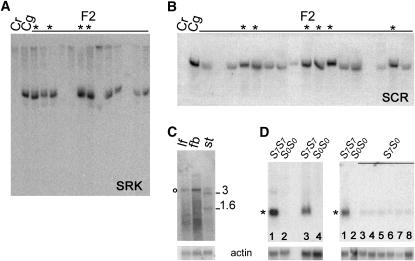Figure 2.—
Molecular analysis of self-incompatibility and self-fertility in Capsella species hybrids. (A and B) DNA gel blots of C. rubella (Cr), C. grandiflora (Cg), and two populations of C. rubella–grandiflora F2 plants probed with the CgSRK7 exon 1 probe (A) and CgSCR7 (B). Only F2 plants indicated with asterisks were self-incompatible and genotypically S7S7 on the basis of pollination assays. All other F2 plants were self-compatible and could be grouped into two classes on the basis of pollination analysis: self-fertile F2 plants that hybridized with the probes were S7S0 while those that did not hybridize were S0S0, as with C. rubella. The small differences in electrophoretic mobility of the hybridizing fragments observed between some of the lanes are due to irregular migration of DNA fragments, which is often associated with the use of relatively impure DNA obtained by mini-preparation methods. (C) Stigma-specific expression of the 3.0- and 1.6-kb CgSRK7 transcripts detected by gel-blot analysis of poly(A)+ RNA from leaf tissue (lf), floral buds with pistils removed (fb), and stigmas (st) of C. grandiflora S7S7. The cross-hybridizing band (circle) common to the three samples represents transcripts from an SRK-related gene. (D) Gel-blot analysis of CgSCR7 in total RNA from C. grandiflora (S7S7) and C. rubella (S0S0) whole floral buds (left, lanes 1 and 2) and anthers (left, lanes 3 and 4) and in the anthers of a representative sample of C. rubella–grandiflora F2 plants (right). Note the lack of hybridization signal in S0S0 plants and the drastic reduction in the steady-state levels of CgSCR7 in the anthers of S7S0 F2 plants (right, lanes 3–8). Hybridization with actin was used as a loading control.

